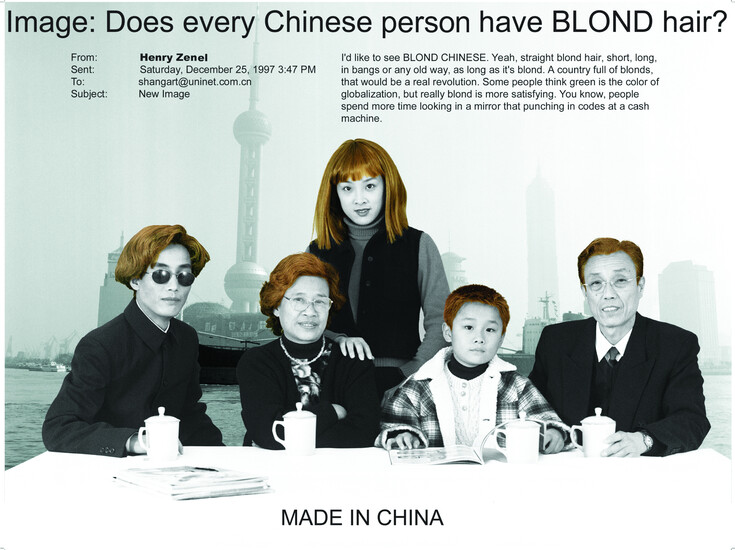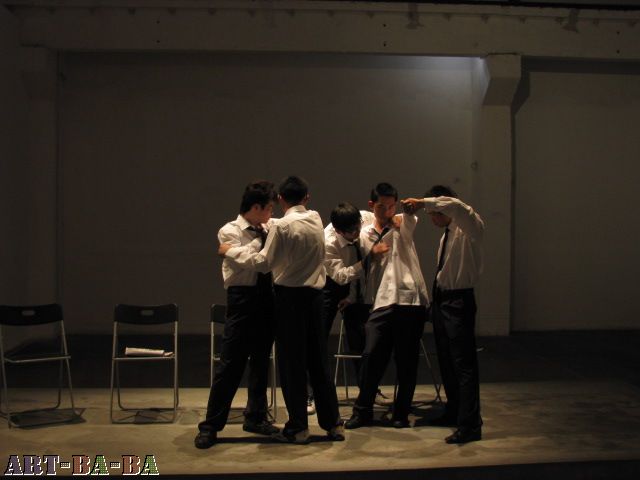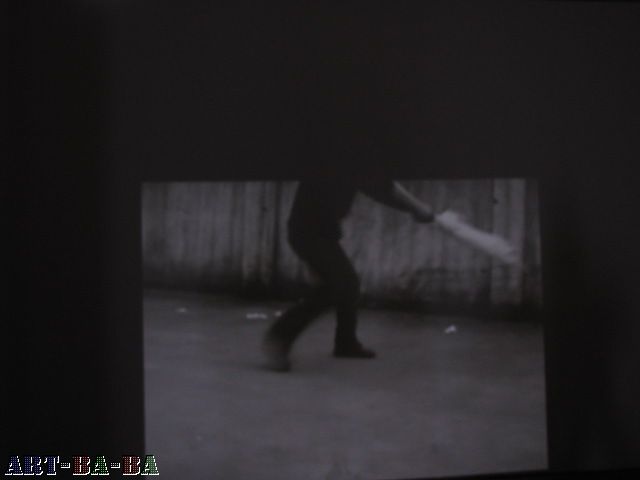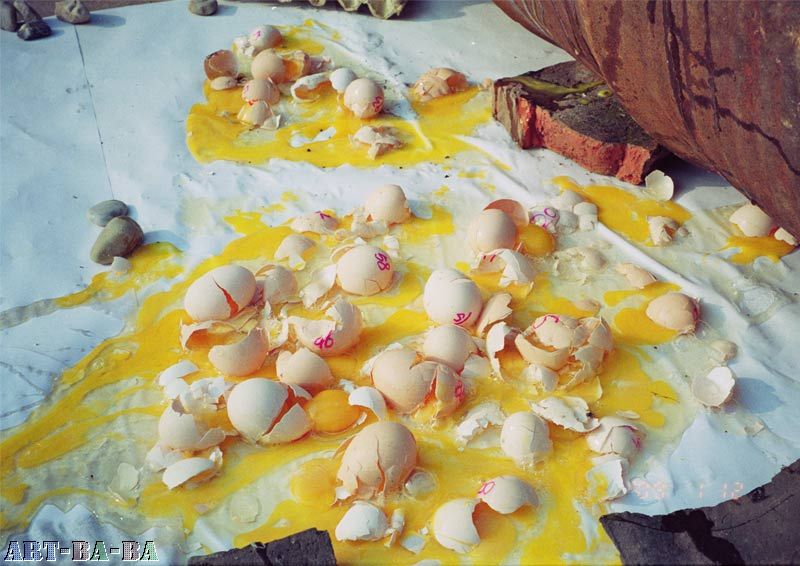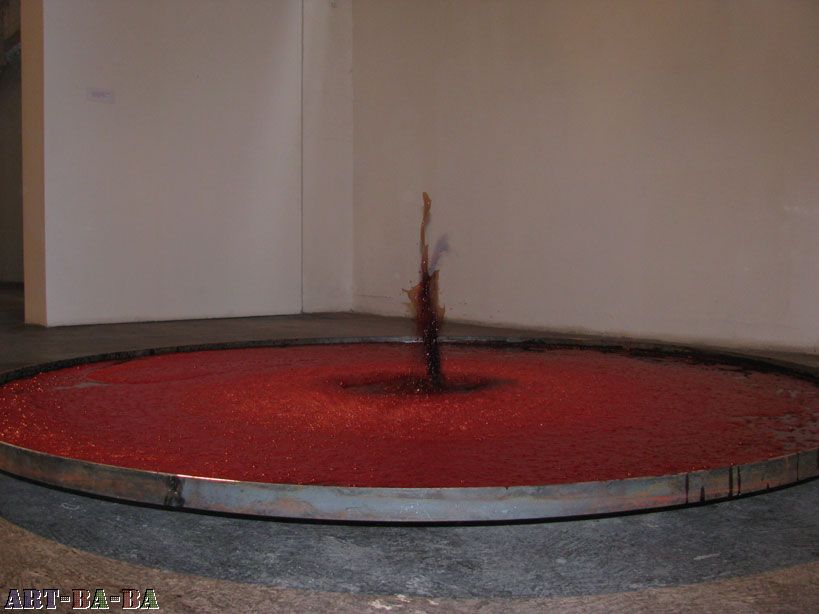A classroom blog on contemporary art & new media in China, w focus on Shanghai. Run by students. Instructor: Defne Ayas (since '06), Francesca Tarocco (since '10). Past lecturers included: Yang Zhenzhong, Qiu Anxiong, Gu Wenda, Ding Yi, Hu Jieming, Birdhead, Zhao Chuan, Lynn Pan, Yang Fudong, Davide Quadrio, Jian Jun Zhang, Barbara Pollack, Lisa Movius, Phil Tinari, Li Zhenhua, Aaajiao, Shi Yong, Xu Zhen, Lorenz Helbling, Yan Pei Ming, ShuFu, Liu Ying Mei. Since Fall 2006.
Thursday, April 30, 2009
On Last Week and Performance Art, Gerry Pryor & Zhu Yu; A Criticism
Group Show at BizArt
It was nice to see some art on display at BizArt over the weekend, since the last time I was there the only thing in the gallery was a badminton net. The current show is , an all women group show. There was a nice variety of work, with every piece being quite good in its own right. As a whole the pieces were stronger on their own than together, but I suppose the fact that they were all made by female artists connnected them. The pieces ranged from conceptual to sculpture, sound, video, bugs, etc. Each piece was well executed both in terms of content and form. One piece that sticks out in my mind was a sort of contraption built of cameras, speakers, TV screens, and little vials containing fish and frogs. At the pace of what I think was a heartbeat, a slight electrical current was sent into the water, shocking the animals. By the time I we (as in Boyang and myself) got there most of the animals were lifeless bodies floating in the water. The ones that were alive would jump of move everytime a shock was sent through the water. Visually the piece was very ineresting, with wires and stands everywhere it was reminiscent of some amd scientist's experiment. While looking at the piece, I couldn't help but think back to the Interrupt show, specifically Wu Ye's Me Too (in which he repeatedly spun a rabbit around and let go of it until it died) and the liberal attitude towards animal life in China. Similar to the fish and frogs was a piece that was a wooden container filled with silkworm cocoons, with a them underneath. The wood was painted white and juxtaposed with the cocoons, there was a uniformity of color that made one look past the fact that there were maybe a couple hundred cocoons on the floor.
Overall the show had a certain playfulness about it, perhaps due to the variety of pieces and somehwat conceptual nature of each of them. And while none of the pieces specifiacally referred to the gender of the artist, as a whole the show exceeded my expectations and is certainly worth a look (unless you find silkworm cocoons gross).
Class last week was enjoyable with both Gerry Pryor from New York giving a short lecture and showing a video of his recent performace, Chance Running, as well as a documentary about 2000's Fuck Off Show. Gerry is somewhat of an art cliche or character, dressed in all black and speaking in a jargon that indicates a wealth of knowledge and expereince. His work, which I ahd not been familiar with prior to seeing the video, was interesting simply because of Gerry's willingness to use his body in a variety of ways in a public space for art. Even at 62 he seems remarkably fit, with his pieces often requiring a certain level of fitness to achieve. I'm not a huge fan of performance, but Chance Running was something to behold, even on video.
The video we watched about the making of the notorious Fuck Off show was maybe not quite as good as seeing the show (before it was shut it of course), but seeing the artist together setting up was a fascinating glimpse into the production of a high-profile art show. Most of what we saw was a number of Chinese artists, including organizer Ai Wei Wei, inflating the skin of a bull or ox. Once again the issue of animal rights is no where to be found and strangely I felt no pity for the animal, despite a number of my classmates around me vocaliziong their disdain.
That's about it for now, see you all on Friday for Zhao Chuan's performance and the Mommy Foundation Party
JAMES COHAN GALLERY
This past week, I went to several small galleries that were enclosed in a small area on Huaihai Road (forgot exactly what the street was), but I'll get to those on a later post. For this post, I wanted to talk about the James Cohan Gallery. Based off of its neighborhood, I would say that I liked the Cohan Gallery more than any of the previous galleries that we have visited--the location was quaint and hidden, almost to a point where I felt that just getting to the artwork was an experience in and of itself. Also, the surrounding environment felt authentic, lived-in, and thriving; it definitely did not feel like the manufactured (and sometimes industrial) spaces of gallery areas.
Thursday, April 23, 2009
Ai Weiwei's political and cultural influece
The artist Ai Weiwei has extensively criticized the unlawful use of governmental power over Chinese citizens, and the poor handling of the Sichuan earthquake devastation in 2008. Spotlighted in a New York Times' article, as well as many party announcements, Ai Weiwei has reached a large number of Chinese people through both his star power (he is most publicly know for helping design the Beijing's Bird's Nest) Internet publications such Ai Weiwei's blog (English translation) are becoming of increasing importance in not only China but also the world.

His sculpture and performance art maintains a keen sense of the current cultural pulse of China, and he remains to be extremely influence to young Chinese artist as well.
I have to admit. I think Ai Weiwei is a really inspiring figure to me as an artist.
Group Show at ShanghART @ 796 Huaihai Lu
 ces with electricity, and Song Tao, whose work on display is a collection of black and white photographs spread across the gallery floor. In addition, there is an installation of "Exposure" by the artist Shao Yi, which explores the themes of our everyday exposure to and dependence on modern technology that affects the way we produce work.
ces with electricity, and Song Tao, whose work on display is a collection of black and white photographs spread across the gallery floor. In addition, there is an installation of "Exposure" by the artist Shao Yi, which explores the themes of our everyday exposure to and dependence on modern technology that affects the way we produce work.Photo: "Exposure", Shao Yi, ShanghART Gallery 2009
Finally, I was happy to come across Xu Zhen's recent work, "18 Days", which I had read about while working on my art presentation. There are photographs on display in the gallery which follow Xu and his team's 18-Day trip, taken in 2006, to China's neighboring countries with the intention of invading them with remote controlled toy weapons. The gallery also presented the documentary on their journey. I enjoy Xu's social commentary/humor. New media projects and contemporary installations are fascinating. The way the artist can fully create the space they are in or organize the various elements and players in their works requires ingenious thinking and coordination.

Photo: "18 Days", Xu Zhen, ShanghART Gallery 2009
The Group Show at ShanghART Gallery @ 796 Huahai Lu, Shanghai, was presented on April 12, 2009 - Apr 19, 2009.
Internet Expression in Contemporary Chinese Art
As a cultural leaders, visual artists have remained at the edge of innovative uses for information technologies. Just as quickly as the artist adapts to new media art production, new ways of implementing the internet become apparent. Today a large number of professional contemporary artist use the internet is some way, at almost every different level of their process.

Artist like Shi Yong, a practicing Shanghainese artist, first used the internet as a key component of his work when he designed a visual survey for non-Chinese to vote electronically for the image of the contemporary Chinese artist. This image is of the postcard, mostly printed in English, that was sent to people around the art world. The card instructs viewers to log onto a special link at Shangart.com to vote on the most appealing hairstyle.
The internet voting was only the beginning of a year long series of performances where the artist acted out the fantasy of hundreds of e-voters. Ultimately he used the outlet to critisize the outlets the Western art world allows Chinese artist.

Electronic resources have created a relatively safe and effective way to convey feelings of unrest withing the strict cultural confines of mainland China.
Quick Links
The slowdown in the Chinese contemporary art market is not surprising, according to Fang Zhenning, an independent art critic in Beijing.
"Art works are commodities, just like sugar or copper. The art market, like any other market, is speculative in nature and has its ups and downs," he said.
Fang said the challenge for China's prominent artists, such as Zhang Xiaogang and Yue Minjun, is to see whether they can keep innovating.
"To change or to repeat themselves. That's the question," he said.
The overheated Chinese art market also raised issues for rising young artists.
"What people are concerned about is all these young artists coming to the art world as a job rather than as a creative thing," said Wallace.
"They've got the skills and they know the market is here. So you see a lot of repetitiveness in their subject matter, particularly in place like 798," he said.
A key problem has been the absence of training programs for museum professionals in China, a country where the term “curator” did not exist ten years ago. Even now, there is only one program in curatorial studies, run by the Central Academy of Fine Arts in Beijing, which is graduating its first class this year. “In China, we didn’t have degrees such as arts management or curatorial studies, so most of the museum directors were originally artists,” says Fan Di’an, who like many directors in China got his position through political appointment. Lack of training is evident at all levels of museum management, as is an absence of professional art handlers and restorers, all of which results in poorly installed exhibitions and damaged artworks, especially at state-run museums. “They have no practice, and they are not interested in developing the proper standards,” comments Marie-Laure Jousset, head of the Pompidou Center’s design department and curator of the exhibition “Fabrica: les yeux ouverts,” which was on view last fall at the Shanghai Art Museum. Jousset had to bring an entire crew of installers and art handlers to Shanghai to ensure proper care of the artworks. “They want the event, and they want our name, but they don’t want to spend money,” she laments. “We had to have long discussions about how a museum has to reach a certain level in order to gain credibility.”
The Art of na lai by Zhao Chuan
it, store it or destroy it. If the owner is the new owner, the house
will become a new house but, first of all, this person has got to be
cool-headed, courageous, discriminating and not selfish. Without na
lai (bringing it in), one cannot possibly become a new person nor can
art and literature start anew.
── Lu Xun
〈na lai'ism〉
7 June 1934
Since the late Qing Dynasty, China has been gradually pursuing a new
cultural target, that of 'modernization'. For this reason, China
has always had to face the source of imagination about this target,
the West, by thinking about various possible inter-positional
relationships between her and the West. In the May Fourth and New
Culture Movements in the early twentieth century, a number of young
intellectuals took the lead, who actively sought a clean break with
the thousand-year-long tradition in which they found themselves
through subversion and fracture, much the way one cuts the messy hemp
with a sharp knife. However, at the same time when they looked for a
West-style cultural knowledge and social formation, they had behind
them a strong nationalistic appeal for social change as they were
urgently hoping for the day to soon arrive when they could run neck
to neck with the Western powers. That revolution that, to this day,
still has not had China run out of its tracks, is considered as a
radical culture movement and has led to a genuinely political Chinese
revolution. After liberation in 1949, the target of
'modernization' in Chinese society turned into a full-scale left-
wing socialist ideal based on the theory of class struggle. By the
end of the 1970s China had experienced the Cultural Revolution and
the closure of itself against the Western capitalist world after
liberation. Before the door of the nation was thrown wide open,
intellectuals and artists were acutely aware of an urgent need to
return to the target of 'modernization'. The pursuit all the way
for new art began then in such a trend that thought took. They first
passionately wanted to break with the new fine arts tradition of
China in which they found themselves, a fake realist art serving
politics, and they then wanted to push for change in social thinking.
Back then, because of our consistent imagination of modernity, we
directly took up in hand a weapon that was Western philosophy and
literature that was hardly explored in depth, particularly the kind
of Western modernism and its subsequent art trends that were almost
out of touch with the contemporary society. In addition, all weird
impulses and things that defied understanding were categorized as
part of Western modernism or had found a basis there. Even then, this
is still na lai, a consciously chosen scheme for transformation.
In that process, artists and commentators in China used terms such as
modernism, modernists, new wave, avant-garde or vanguards to refer to
new art and to define the art that was happening, references that,
judging from today's vantage position, did not quite match the
Western context that they had wanted to quickly enter into. These
Western artistic terms that came mainly from the West were, for the
most part, outdated for the West in the 1980s and 1990s. However,
this was not a real issue in the 1980s when there was a relative
distance between China and the outside world and when the focus was
on its own problems. The title of the most important exhibition,
Modern Chinese Art Exhibition, at the end of the 1980s, was not
rendered as 'China Modern Art Exhibition' in its English
translation. In the words of Gao Minglu, its curator, it was
translated as 'China/Avant-Garde Exhibition', based on 'its true
original meaning', that is, 'China Avant-garde (or Vanguard) Art
Exhibition'. Obviously, when one is aware of a global context, the
word 'modern' sounds outdated and out of place. But why 'avant-
garde'? What is the true original meaning of these new arts in
China? In their understanding then, the word 'modern' had an
absolute evolutionary meaning. The new-wave art in the entire 1980s
China was an effort made to welcome its arrival, which made a major
contextual difference from modernist arts that were opposed to the
materialistic capitalist society subsequent to the industrial
revolution in the West. Even though Western modernist art process was
in fact one of our main references, the word 'modern' was a
Chinese term in the unique Chinese context. If one wouldn't mind
sounding extreme one could say that it would be xiandaism, not
modernism, if written into a history of art in English. It wouldn't
be 'avant-garde', either, because it was an artistic formation in
a seriously Western context although it did display the radical
relationship between art and the society in which art found itself.
In the early 1990s, the 'Chinese Avant-garde' was used in the
local art circles and the exhibitions that went to the West, becoming
internationally known. By the early twenty-first century, the new art
has not only been found conditionally acceptable by the official
Chinese art institution but has also basically collaborated with the
globalized contemporary art system. For this reason, no-one actually
disputes the replacement of 'modern' or 'avant-garde' with the
term 'contemporary art' that follows the current international
trend. For art in the previous hard process, it is its own new art
but with embarrassing old garments and hats as they were once used by
others. These are terms that have their own specific meaning in the
process of na lai as they have their equivalent fixed usages in their
Western source that refer to a certain age. Under the global pressure
that includes a postcolonial consciousness, it is either easy for
these appellations to induce simplistic reading or hard for them to
identify themselves.
It is an adventure to use 'radicalism' instead of the terms that
have been habitually used for decades, not accurate for me but used
in a fixed manner, such as 'avant-garde' or 'modern art'.
Meanwhile, this naming provides a clear link with the modern cultural
and ideological trend in China. As some scholars say, rationalism and
radicalism are either face of a coin. For this reason, the
ideological base for radical art is rationalism. However, because it
is art, it inevitably moves towards a political romanticism by
believing in abstract liberation and passionate impulses in concrete
terms. Although this radical art can keep creating new patterns, it
is not art for art's sake as its ideological trend is of particular
importance, that is, its combat with the orthodoxy, which becomes a
harbinger of liberation. For this reason, this art in the 1980s
lacked a creation of genuine formalism as it was not the Western
modernism that had entered formalism but it intended to guide our
society in its movement towards 'modernization' through gaining
various kinds of liberation. The desire for liberation came not only
from a rebellion against long-term political restrains but it also
touched upon the understanding of the absolute importance of free
will in Western modernity. From the late 1970s to the early 1980s,
when radical art grew generally clearer about this issue, its
distinct ideological trend naturally joined forces with the
ideological liberation movement as one party to the then mainstream
politics in China and with the more minjian new enlightenment, in the
direction of total values, turning into the actively rebellious 85
Art New Wave Movement that spread across the country in the 1980s.
After radical art suffered a setback in the aftermath of June 4th,
1989, part of it was engaged in soul-searching around the time,
struggling to move ahead, and another part changed with the
transformation of the Chinese society or was abandoned. It is not
till the mid-1990s and the late 1990s, when the overseas market and
contemporary art system arrived wholesale, that the remaining 1980s
interest, in the face of a changing environment and changing issues,
gradually moved onto the next generation of art with renewed ideas.
The simple initiativeness of na lai, as proposed by Lu Xun, the flag-
bearer in the New Culture Movement of the last century, has now
become murky in the face of the West that is so important to our
'modernization', getting stuck in the deep entanglement of giving,
taking, buying and selling, colonizing, postcolonizing and
multiculturalism.
Radicalism as a term is not something entirely new. In the past in
the accounts of this area, it most often referred to a localised
direction in some time segments and was occasionally used as an
adjective. The radical art that here attempts to sum up and discuss
is not a school but a summary of forms of artistic practice in that
generation or over a longer period of time. It is characterized by
its concept and scope that emphasize its own ideological trends
although it certainly does not include all of the new-wave art in
those days. Before its diversion, turning away and wearing out, the
features of its vigorous action had actually provided an upsurge of
artistic energy for Shanghai and for the whole of Chinese society.
Wednesday, April 22, 2009
Xu Bing's Universal Language

What Poly Auction is doing with all this money...
Matters of Faith at James Cohen Gallery
Matters of Faith succeeded in bringing four artists from different places, who work in a variety of different media together, connnected via a similar and, as the show would argue, universal theme. Definitely worth a visit.
http://www.jamescohan.com/exhibitions/2009-03-27_matters-of-faith/
Monday, April 20, 2009
Mommy Foundation - Inauguration party
Venue: CANART Institute for Contemporary Art , Ding Xi road 727
Presented by
Mommy Foundation
Partner of event:
CANART Institute for Contemporary Art
Special Thanks to Split works
www.spli-t.com
Party Introduction
This party is to inaugurate the birth of Mommy Foundation and to
raise awareness of importance of supporting young talents and their
work in early stage. Party will feature number of young artist's
projects and interventions during evening
Don't miss the unique night in town. Free drinks for first hours,
good DJ and various artists and friends interventions during evening.
Come dressed in crazy colors and mommy mood
Everybody welcome and don't forget to bring your friends
Some of the artists projects to be featured Street Gallery: more than
60 artists from all over China will participate in project. Each
piece provided by artists will be on sale same evening with price NO
MORE THAN 100RMB
Birdhead's Patrol: Birdhead collective will provide their services on
site in collector's house and private setting, artists Li Mu , Gao
Mingyan, To Be Band great friends Lisa Movious and many many others
will make your evening more then special more then a only party
Mommy Foundation- A foundation for supporting young Chinese artists
and projects)
Thursday, April 16, 2009
Interrupt. Jin Shan. German Student Show.
Stephen the Spectacular (jin Shan solo exhibition) - ddmwarehouse
April 14th - German Student Show - Shanghai Theatre Academy
While the pieces were quite different and unrelated, the Interrupt show lived up to its purpose - to have no purpose. This sounds like a negative thing, but in fact it was quite the contrary. The artists "interrupted" the flow of how art is made, displayed, viewed with a variety of different mediums including video, performance, installations, etc. While at first the pieces seem well executed, yet none too memorable, upon further examination and research, Interrupt becoems a remarkably brutal show. The content of the pieces carried with them an almost sinister edge, especially the works of Li Pinghu, Wu Ye, Li Ming and Wang Xiaofeng. The added element of danger greatly augments the effectiveness of the show considerably. The purpose of "interrupting" becomes more clear as the artists do not shy away from crassness of real blood or even death. Wang Xiaofeng's Source uses sound to spew pig's blood a few feet into the air. Each viewer let out a primal scream and watched the blood fly into the air. Upon reflection the interaction is quite morbid, however while doing it and not knowing that the pool was actually real blood, Source was really fun. Reminds me of primordial soup now that I think about it. More immediate was Wu Ye's Me Too, a video in which the artist spins around while holding a rabbit outwards. Eventually Ye loses his balance and the rabbit is launched away. It a horrifying site made even more horrifying when the artist gets up and does it again until the rabbit dies. I was taken aback but morbidly curious at the same time and thought of how a piece like this would not be possible in New York (showing this in New York would really be an interruption, to say the least). Other pieces include Li Ming's Doctor Ou Yang's Midnight - a short film about a doctor examining and being repulsed by his own body. While the video is certainly graphic, it seems like it's meant to shock and beyond that is just a chore to watch. Also Li Pinghu's performance (which I actually missed) where five men dressed in business suits begin to pick away at a layer of fake skin. The aftermath was not gruesome by any means, but the strewn papers and disrupted chairs remained untouched throughout the day. Aside from the more gross pieces were a number of playful installations such as doodles on packages and Yi Ming's 99 and 1, a documentation of an experiment done to determine the strongest egg of a batch of 100. While at first Interrupt seemed somewhat run-of-the-mill, it actually ended up being quite memorable for the artists lack of fear and utter disregard for the conventional method of art-making.

Next was ddmwarehouse to see Stephen the Spectacular, a solo exhibition by Jin Shan. I was very excited for the show from the pictures promoting it. While the show itself was enjoyable, it was strange and lacked the energy I had anticipated (maybe its because I was about 1.5 hours late). The performers didn't do much other than look bored, and most of the other parts seemed static both physically and artistically. I felt little walking through the makeshift shelter and even the operating table with the taxidermy goat. Perhaps it was the lighting of the studio shoot compared to the bright harsh lighting of ddmwarehouse that detracted from the work. Also the new location contained a great deal of unfinished construction that almost "infected" the show, even leading me to believe the show was perhaps unfinished. Following the visit I reread the artist statement, which in a way lowered my feelings about the show even more. I did not perceive the themes of martyrs, which Shan stressed. Overall Stephen the Spectacular has some interesting visuals and costumes, but overall was a bit of a let down.
Missed the Andre Kneibs opening at Contrasts much to my dismay. I'll probably go sometime next week.
While at the Jin Shan show we met some German art students studying abroad with a show on Tuesday at the Shanghai Theatre Academy. The cards promised "more cold beer" (there was some), but said little about the actual works. The show definitely had the feeling of a student show with a couple of pieces needing some work in terms of execution. However the opening was rather fun due to the organizer - Rainer...something. A teacher with messy hair and sunglasses, speaking to everyone and offering them alcohol that smelled exactly like ethanol. The only piece that stood out for me was a photography triptych that showed a red string starting at the ground, climbing past eye level, and finally disappearing into the sky. It was simple, but well executed and clean.
photos from Art-Ba-Ba Blog, http://www.art-ba-ba.com
Thursday, April 09, 2009
Xu Zhen
Shi Yong's 'Yearning'
